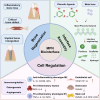Metal-phenolic network biointerface-mediated cell regulation for bone tissue regeneration
- PMID: 39759849
- PMCID: PMC11699301
- DOI: 10.1016/j.mtbio.2024.101400
Metal-phenolic network biointerface-mediated cell regulation for bone tissue regeneration
Abstract
Bone tissue regeneration presents a significant challenge in clinical treatment due to inadequate coordination between implant materials and reparative cells at the biomaterial-bone interfaces. This gap underscores the necessity of enhancing interaction modulation between cells and biomaterials, which is a crucial focus in bone tissue engineering. Metal-polyphenolic networks (MPN) are novel inorganic-organic hybrid complexes that are formed through coordination interactions between phenolic ligands and metal ions. These networks provide a multifunctional platform for biomedical applications, with the potential for tailored design and modifications. Despite advances in understanding MPN and their role in bone tissue regeneration, a comprehensive overview of the related mechanisms is lacking. Here, we address this gap by focusing on MPN biointerface-mediated cellular regulatory mechanisms during bone regeneration. We begin by reviewing the natural healing processes of bone defects, followed by a detailed examination of MPN, including their constituents and distinctive characteristics. We then explore the regulatory influence of MPN biointerfaces on key cellular activities during bone regeneration. Additionally, we illustrate their primary applications in addressing inflammatory bone loss, regenerating critical-size bone defects, and enhancing implant-bone integration. In conclusion, this review elucidates how MPN-based interfaces facilitate effective bone tissue regeneration, advancing our understanding of material interface-mediated cellular control and the broader field of tissue engineering.
Keywords: Biointerface; Bone tissue regeneration; Immunoregulation; Metal-polyphenolic networks; Stem cells.
© 2024 The Authors.
Conflict of interest statement
The authors declare that they have no known competing financial interests or personal relationships that could have appeared to influence the work reported in this paper.
Figures











Similar articles
-
Metal Phenolic Nanodressing of Porous Polymer Scaffolds for Enhanced Bone Regeneration via Interfacial Gating Growth Factor Release and Stem Cell Differentiation.ACS Appl Mater Interfaces. 2022 Jan 12;14(1):268-277. doi: 10.1021/acsami.1c19633. Epub 2021 Dec 28. ACS Appl Mater Interfaces. 2022. PMID: 34961319
-
Unlocking the Potential of Gallic Acid-Based Metal Phenolic Networks for Innovative Adsorbent Design.Molecules. 2025 Mar 8;30(6):1218. doi: 10.3390/molecules30061218. Molecules. 2025. PMID: 40141997 Free PMC article. Review.
-
Applications of X-ray computed tomography for the evaluation of biomaterial-mediated bone regeneration in critical-sized defects.J Microsc. 2020 Mar;277(3):179-196. doi: 10.1111/jmi.12844. Epub 2019 Nov 20. J Microsc. 2020. PMID: 31701530 Review.
-
Janus porous polylactic acid membranes with versatile metal-phenolic interface for biomimetic periodontal bone regeneration.NPJ Regen Med. 2023 Jun 3;8(1):28. doi: 10.1038/s41536-023-00305-3. NPJ Regen Med. 2023. PMID: 37270633 Free PMC article.
-
Metal-phenolic network coatings for engineering bioactive interfaces.Colloids Surf B Biointerfaces. 2021 Sep;205:111851. doi: 10.1016/j.colsurfb.2021.111851. Epub 2021 May 14. Colloids Surf B Biointerfaces. 2021. PMID: 34020152 Review.
Cited by
-
Layered double hydroxides for regenerative nanomedicine and tissue engineering: recent advances and future perspectives.J Nanobiotechnology. 2025 May 22;23(1):370. doi: 10.1186/s12951-025-03448-1. J Nanobiotechnology. 2025. PMID: 40405242 Free PMC article. Review.
-
Metal-Phenolic Network-Directed Coating of Lactobacillus plantarum: A Promising Strategy to Increase Stability.Foods. 2025 Jun 26;14(13):2277. doi: 10.3390/foods14132277. Foods. 2025. PMID: 40647029 Free PMC article.
-
Gynecologic postoperative anti-adhesion barriers: From biomaterials to barrier development.Biomater Biosyst. 2025 Aug 5;19:100115. doi: 10.1016/j.bbiosy.2025.100115. eCollection 2025 Sep. Biomater Biosyst. 2025. PMID: 40809697 Free PMC article. Review.
-
Adhesive micro-liquid for efficient removal of bacterial biofilm infection.Mater Today Bio. 2025 Jan 27;31:101525. doi: 10.1016/j.mtbio.2025.101525. eCollection 2025 Apr. Mater Today Bio. 2025. PMID: 39958232 Free PMC article.
-
Microenvironment-responsive nanoparticles functionalized titanium implants mediate redox balance and immunomodulation for enhanced osseointegration.Mater Today Bio. 2025 Mar 2;31:101628. doi: 10.1016/j.mtbio.2025.101628. eCollection 2025 Apr. Mater Today Bio. 2025. PMID: 40124346 Free PMC article.
References
-
- Feng P., Zhao R., Tang W., Yang F., Tian H., Peng S., et al. Structural and functional adaptive artificial bone: materials, fabrications, and properties. Adv. Funct. Mater. 2023;33(23)
-
- Langer R., Vacanti J.P. Tissue engineering. Science. 1993;260(5110):920–926. - PubMed
-
- Hao J., Malek N.A.N.N., Kamaruddin W.H.A., Li J. Breaking piezoelectric limits of molecules for biodegradable implants. BME Mat. 2024;2(2)
Publication types
LinkOut - more resources
Full Text Sources
Miscellaneous

